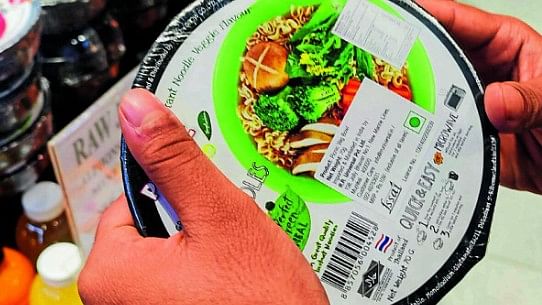
Experts say food labels help people understand ingredients and nutritional value of the products they plan to buy or consume.
DH Photo/B H Shivakumar
The awareness about reading food labels beyond manufacturing and expiry dates, and pricing is slowly growing in Bengaluru. Experts say laypersons are keen on understanding front-of-pack labelling claims such as ‘100% natural’ and nutritional tables printed at the back of packaged foods.
In the past two weeks, food safety as well as nutrition consultants in the city have spoken about the importance of food labels on packaged products during events. June 7 was World Food Safety Day. On an India-level, influencer Revant Himatsingka aka FoodPharmer has launched an online campaign asking people to read food labels and question misleading claims by FMCG companies.
Confusing information
Covid-19 set things rolling for this change. Packaged foods like sprouted seeds exploded so did functional drinks, with each brand claiming to be healthier than others. “With so many claims going around, people were both curious and confused,” Ranjani Raman, chief dietician, Nutrition Tattva, says about the growing buzz.
Then the Food Safety and Standards Authority of India (FSSAI) came into the picture, passing the Food Safety and Standards (Labelling and Display) Regulations in 2020. Their subsequent proposal for front-of-pack nutrition labelling was opposed. It was to give star ratings to products based on their salt, sugar, and fat content. The rise of health influencers like FoodPharmer and The Liver Doc and celebrities investing in plant-based meats added to the scrutiny.
However, not everybody is up for education. “When we approach schools to teach students how to read food labels correctly, schools think we are promoting packaged foods,” says Ramesh Agarwal, CEO, Food Safety Works.
Look through ingredients
Food labels help people make an informed choice, especially those who are health conscious or vulnerable. Some products are not recommended for pregnant women or children, so keep an eye out for the warning, says Ranjani.
She says the longer the list of ingredients, the more processed the product is likely to be — plain oats versus masala oats is a case in point. If the list has many unfamiliar terms, proceed carefully. “Mannitol, sorbitol and dextrose are hidden forms of sugar. High-fructose corn syrup (HFCS) is also a kind of sweetener. Hydrogenated fat is another name for unhealthy fats like dalda,” she points out.
And if you are looking to drop weight, focus on calories per serving size and multiply that number with the total content. “Be watchful of products that mention more than 200 calories in any serving size,” she says.
Too many claims
Experts say claims like ‘no added preservatives’ and ‘organic’ call for a thorough reading. “If a product is organic, look for the Jaivik Bharat certification. Products can contain trace amounts of trans fat but still print the ‘zero’ claim. And you will be surprised how little actual soy milk is in a tetra pack of ‘soy milk’,” shares Ranjani.
Dr Mamatha Mishra, founder, Health First, says consumers should buy healthy packaged foods with their eyes wide open, with a focus on nutrition details, expiry date and allergens.
Her quick pointers: no sugar means no added sugar, and chewing gums and bubble gums don’t need to declare expiry dates. She continues, “If a fruit juice has minimal fruit pulp, it needs to be marketed as juice and not fruit juice. Packaged coconut water is sold as coconut juice because it is reconstituted coconut water — not tender coconut water,” she says.
Even Agarwal asks consumers to not fall for claims blindly. He cites an example: “What is a cholesterol-free vegetable oil? Plants have no cholesterol.”
He calls attention to reading sugar content — if added sugars form the bulk of total sugars, then “it’s concerning”. He says consumers are most worried about additives and preservatives. INS numbers indicate 0–199 (colours), 200–299 (preservatives), 300–399 (antioxidants and acidity regulators) and 400–499 (thickeners, stabilisers and emulsifiers). “Look out for these codes and Google up more information about them,” he says.
Be wary of packaged foods, even nutraceuticals, promising medical benefits like reduction in joint pain. “So brands resort to ingredient-based claims, like printing the goodness of turmeric. That is acceptable,” he says.
Sharing a common fallout of not reading nutrition details, Dr Mamatha says, “Some people wonder why they aren’t seeing the results they want.”
How consumers buy packaged foods
In 2023, Bengaluru-based Food Safety Works conducted a survey of 420 people to study their behaviour while buying packaged foods. Key findings:
53.6% always look out for food labels.
51.7% check the nutrition facts label.
70.7% feel calories is the most important fact.
47.4% occasionally check ingredients.
89% always check the expiry date.
30.7% occasionally check for allergen or warning labels.
28.3 % were aware of the FSSAI logo.
74% check for vegetarian and non-vegetarian logos.
61.2% give preference to organic health claims.
42.9% have never used customer care information to file a complaint.